5 Tips to Uplift Your Organization Design

Organization design plays a crucial role in shaping the effectiveness and efficiency of a company. At a time where certainty is hard to come by, and paradigm shifts are a norm, organization restructuring goes beyond simply rearranging blocks on an organization chart.
The 5 Tips to Uplift Your Organization Design
To truly uplift your organization design, you need to think “outside the box” (no pun intended) and consider the interconnectedness of various factors within your organization. In this article, we will explore 5 tips that can help you optimize your organization design for better performance and success.

1) Think outside the box…and lines – Embrace Systems Thinking
Many professionals still perceive organization design as a mere restructuring exercise focused on the organization chart. However, this approach overlooks the holistic nature of organization design. As the famous saying goes, changing the organization chart amounts to moving around the deck chairs in a sinking titanic – it doesn’t solve the root cause of problems. To address performance problems effectively, you must consider the underlying reasons for redesigning.
For instance, if you aim to become more customer-centric, creating a new department may seem like a solution. However, the true essence of customer-centricity lies in aligning your structure, culture, people, and processes with this objective. Too often, when a problem occurs, the finger is pointed at the structure, where in reality it may only play a minor role in the underlying root cause.
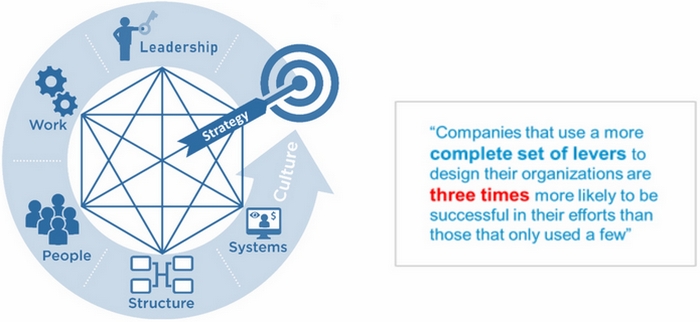 Figure 1: Designing with a system lens often leads to better outputs and business results
Figure 1: Designing with a system lens often leads to better outputs and business results
Remember that your organization is an interconnected system where changes in one area can impact the entire system. By embracing systems thinking, you can ensure that your organization design efforts yield meaningful results.
Case in Point: Pixar
In 2020, Forbes covered the acclaimed animation studio’s meteoric success, revealing that Pixar doesn’t believe in “departments for creativity”. Instead, the culture and processes are designed to encourage creative thinking on an individual level, no matter the department. At Pixar, film leaders make all operating decisions; their bosses don’t have to second guess or micromanage them.
The creative decision-making authority lies solely on the film’s creative leadership. Managers only get involved when production is running into a problem.
2) Give Strategic Functions Line of Sight – Focus on What Matters Most
To establish a clear line of sight between your strategic functions and the CEO, it is important to ensure that the most strategic units in your organization report directly to top-level leadership.
For example, if your organization is striving to cut costs, and is at the core of a company’s strategy, then it may make sense to ensure that the cost transformation function report directly to the CEO. Or if your future direction is underpinned by innovation, then you should consider your innovation department to report directly to the CEO. With a more dynamic “start-up” approach to leadership replacing traditionally hierarchical structures, the CEO’s span of control has risen steadily within the 21st century.
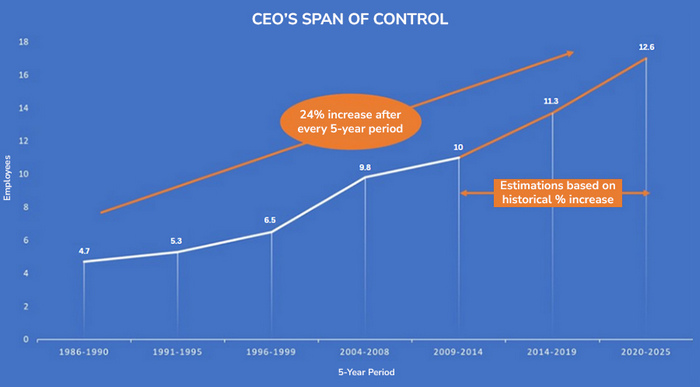 (Sources: Harvard Business Review, Sullivan Cotter, Caliber Consulting)
(Sources: Harvard Business Review, Sullivan Cotter, Caliber Consulting)
Figure 2: CEOs span of control has risen considerably in the last 2 decades
This direct reporting enables swift decision-making and ensures that strategic functions receive the necessary attention and support from top leadership. By granting line of sight to critical departments, you strengthen their impact on the overall organization strategy.
Case in Point: Amazon
The S Team, a group of 28 senior executives, works closely with CEO Jeff Bezos at Amazon (FourWeekMBA, 2023). Each member of this highly capable team leads key functional business units, many of which are sizable organizations in their own right. The S Team collaborates with Bezos to communicate his vision, address challenges, establish strategic objectives, and shape the company’s overall culture. They oversee various function-based groups within Amazon, such as finance, human resources, corporate affairs, Amazon Web Services (AWS) etc.
3) Don’t Design around People – Focus on Methodical Design
“Organization structures rarely result from systematic, methodical planning. Rather, they evolve over time, in fits and starts, shaped more by politics than by policies”
Designing around people, based on personal relationships and subjective preferences, is all too common, even amongst top companies. But this can result in irrationally structured teams that are difficult to manage. These “biased” structures often arise from organic growth over time and can lead to confused accountabilities and complex reporting lines.
By prioritizing activities first, grouping them effectively, and then considering the capabilities required for each group, organizations can ensure a more rational alignment of talent with job requirements (see figure 3). This approach avoids being driven by individual personalities, resulting in a resilient structure that is less susceptible to future changes and personnel transitions.
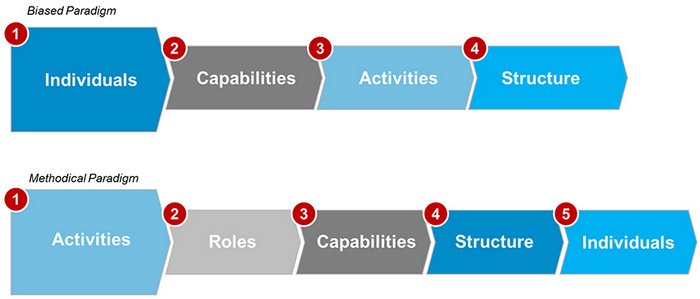 Figure 3: Design your structure around activities and capabilities, not personality
Figure 3: Design your structure around activities and capabilities, not personality
Case in Point: Netflix
Netflix’s organization design defies the conventional approach of designing around people, instead prioritizing the development of robust systems that drive their success.
A recent article by Forbes characterized the culture as possessing radical transparency, accountability, and high performance, which sets clear expectations for employees. Furthermore, rather than relying solely on personal preferences, Netflix’s structure prioritizes outcomes, innovation, and adaptability. This approach goes beyond traditional logic, demonstrating that designing around systems and a strong culture can yield remarkable results, propelling the organization to new heights of success.
4) Optimize Spans & Layers – Find the Right Balance
The importance of spans and layers in organizational design lies in finding the right balance for efficient and effective operations. A flatter organization with fewer layers and a wider span of control can promote faster communication and decision-making but might challenge managerial control. On the other hand, a more hierarchical structure with more layers and a narrower span of control might offer better control but could slow down communication.
Organizations often need to strike a balance based on their size, industry, and specific goals. The design affects the flow of information, the speed of decision-making, and the overall agility of the organization. It’s about finding the optimal organizational structure that aligns with the company’s strategy and fosters a productive and collaborative environment.
The number of employees reporting to a manager can significantly impact organization efficiency and employee engagement. Optimizing spans and layers involves considering various design levers (see figure 4) such as work complexity, coordination, team maturity, and communication.
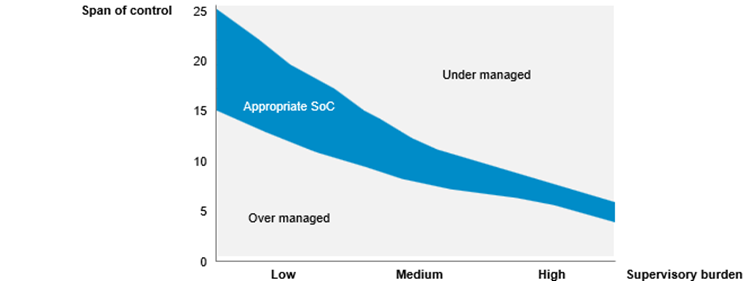
Figure 4: Spans and layers analysis can help streamline an organization structure

In a call center with repetitive and standardized tasks, a manager can effectively oversee a larger span of control, perhaps up to 20 employees. However, in departments like research and development (R&D), where individual attention and specialized guidance are essential, a lower span/layer is preferable. By finding the right balance and optimizing spans and layers based on the unique needs of each department, you can enhance performance and create a more effective organization structure.
Case in Point: Google Vs General Electric
At Google, a dynamic, fluid set of individuals may yield high output in terms of complex innovation. The number of team members reporting to a manager is between 7-10. This makes sense as it allows more bandwidth for a manager to leverage her dynamic team quickly.
At a company like General Electric (GE), where manufacturing processes are more standardized, a large, well-trained team will enable increased manufacturing capacity. This is why, at GE, up to 400 employees may report to a single plant supervisor.
5) Know When to Group and When to Separate Functions – Foster Alignment and Specialization
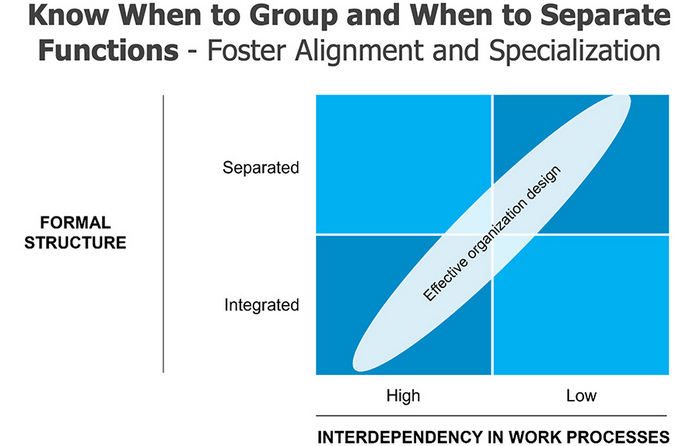 Figure 5: Effective organization 2×2 Matrix
Figure 5: Effective organization 2×2 Matrix
The decision to group or separate functions within your organization can depend on several factors. If there are conflicts of interest between the objectives of two functions, separating them can ensure clarity and prevent potential friction. On the flip side, two departments sharing similarities in their objectives or requiring increased collaboration can be grouped together to enhance synergy and efficiency.
For example, a manufacturer of automated machinery may consider merging its marketing and sales department if certain criteria are met (see figure 5). Both departments might have the same KPIs to judge their efficacy, i.e., higher sales. But there would also be very high interdependency and need for coordination, as is traditionally the case with B2B sellers.
By carefully considering the nature of functions and the need for collaboration or specialization, you can determine the optimal grouping or separation strategy for your organization.
Case in Point: Apple
As Apple expanded and ventured into new markets, CEO Tim Cook recognized the need for adjustments in their functional structure and leadership model. According to a 2020 article, to foster continuous innovation and allow room for key business units to succeed, Apple strategically divided the hardware division into separate entities for engineering and new technologies. They established a new unit, focused on AI and machine learning as a distinct area, acknowledging the growing significance of these technologies.
This approach facilitated efficient use of expertise across personnel and processes, leading to the continuous innovation that has become synonymous with the company.
The 5 Tips as a Blueprint
These 5 tips point towards an improved organization design that considers the interconnectedness of various elements within your company. Tweaking one lever and ignoring others will only tangle the knot further. Remember, every organization is unique, and these tips along (with other key design principles) should act as guidelines to design structures geared for performance.

